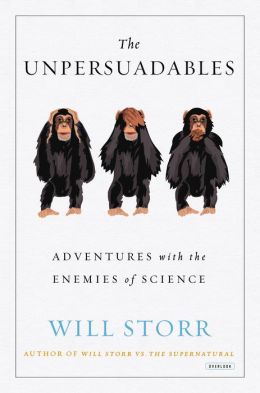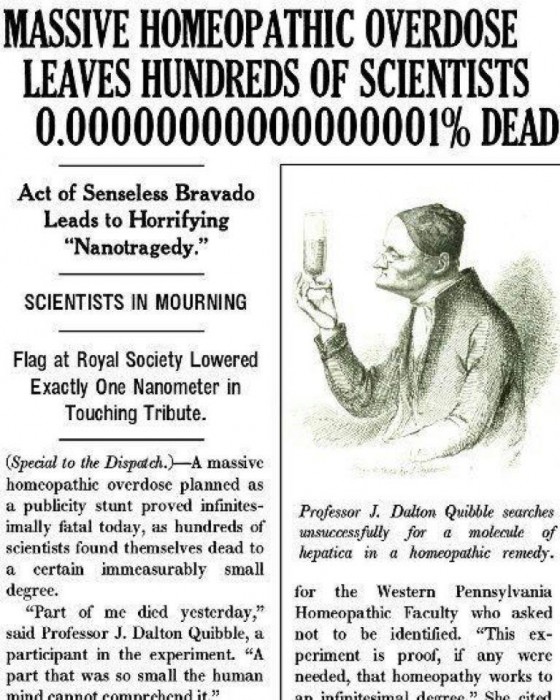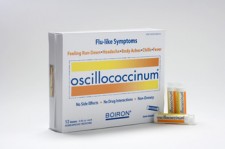by
Donald Prothero, Jul 02 2014

A review of The Unpersuadables: Adventures with the Enemies of Science, by Will Storr (2014, Overlook Press, New York).
Most of us long-term skeptics have had our share of run-ins with people who cling stubbornly to a particular dogma. We get frustrated that no amount of evidence or strong arguments ever changes their point of view. The pattern is true whether you’re dealing with religious beliefs (from creationism to various Eastern religious ideas), or paranormal beliefs (UFO nuts, psychics, ghosts, cryptozoology) or just plain pseudoscience and bad scholarship (homeopathy, past-life regression, Holocaust deniers, climate-change deniers, and many others). Reporter Will Storr decided to go deep into the heart of these various fringe and non-scientific belief systems, interviewing the major figures, taking part in their rituals, and doing his best to give them a fair shake as he embeds himself into their culture. Continue reading…
comments (10)
by
Steven Novella, Mar 25 2013
Six years ago I was asked to participate in a group debate over the legitimacy of homeopathy at the University of CT (there were six speakers, three on each side). This year I was asked to participate in another homeopathy debate at UCONN, but this time one-on-one with Andre Saine ND from the Canadian Academy of Homeopathy taking the pro-homeopathy side. (I will provide a link when the video is posted online.)
While the basic facts of homeopathy have not changed in the past six years, the details and some of the specific arguments of the homeopaths have evolved, so it was good to get updated on what they are saying today. In this post I will discuss some overall patterns in the logic used to defend homeopathy and then discuss the debate over plausibility. In tomorrow’s post I will then discuss the clinical evidence, with some final overall analysis.
Believers and Skeptics
As with the last debate, the audience this time was packed with homeopaths and homeopathy proponents. When I was introduced as the president of the New England Skeptical Society, in fact, laughter erupted from the audience. But that’s alright – I like a challenge. It did not surprise me that the audience, and my opponent, were unfamiliar with basic skeptical principles. Andre, in fact, used the word “skeptic” as a pejorative throughout his presentation.
Continue reading…
comments (27)
by
Donald Prothero, Dec 05 2012

Most of us have read about homeopathy, and its claims to be an effective form of medicine. It was first developed by the German physician Samuel Hahnemann in 1796, and based on the old Greek and Medieval “Principle of Similars,” or the idea that “like cures like.” For example, Hahnemann observed that cinchona bark helped treat malaria in sick people, and caused similar symptoms in healthy people, so he reversed the logic and reasoned that whatever causes similar symptoms can be used to treat it. (Cinchona bark does contain natural quinine, a cure for malaria). He argued that if poison ivy causes skin rash, then diluted poison ivy is a cure for skin diseases. But his theory of “likes cure likes” was pure Medieval alchemy and mumbo-jumbo, completely invalidated when modern chemistry developed in the nineteenth and twentieth centuries. This archaic version of pre-modern medicine has persisted virtually unchanged until today. The ingredients used in homeopathy sound like those of a witch doctor or medieval apothecary (or something out of Harry Potter’s potions class): snake venom, ground honeybee, crushed bedbugs, live eels, wolf milk, arsenic, poison ivy, diseased tissues (including pus, tumors, feces, plus urinary discharges, blood and tissues from sick individuals), quartz, gold, oyster shell, and common salt. Their other ingredients, known as “imponderables”, supposedly “capture” electromagnetic energy by exposing alcohol or lactose to sunlight, X-rays, or lightning.
What makes homeopathy different from other alternative medicines that use bizarre ingredients is their key method: dilution. All these substances are then ground into fine powder to make a “tincture”, diluted in water, and then diluted over and over again. The “hitting” or “shaking” technique by the homeopath is very important because of “kinetic energy input” and its effect on their medicine. (This is just a fancy way of saying that more shaking probably mixes a solution better, but it is given a mystical mumbo-jumbo meaning in homeopathy). A typical homeopathic remedy has a “strength” of “30C” in their terminology. This means that the original agent has been diluted 30 times by a factor of 100 each time. A simple calculation means that this material has been diluted by a factor of 1 x 1060, or 1 followed by 60 zeroes (in common terms, one part “tincture” in one million trillion trillion trillion trillion trillion trillion parts of water). There are only 3 x 1025 molecules of water in a liter, so for all intents and purposes, there are no molecules of the “active ingredients” left and the homeopathic remedy is just water and nothing more. At this concentration, a patient would need to swallow 1041 pills (a billion times the mass of the earth) or 1034 gallons of elixir (a billion times the volume of the Earth) to consume even a single molecule of the substance. Even a stronger homeopathic solution of “12C” has only a 60% chance that one molecule of the tincture is present. Yet according to homeopathic theory, the medicine is stronger the more it is diluted. Most homeopathic remedies have been diluted so much that they are just small bottles of water. In effect, homeopathy has become the modern “water cure.” Continue reading…
comments (14)
by
Brian Dunning, Jul 05 2012
SkepticBlog correspondents received multiple copies of a troubling email that was sent en masse to students and staff at Singularity University in the San Francisco bay area. Singularity University is a private institution that offers courses on emerging technologies to people. It’s an unconventional company, with an unconventional staff: most of its programs are headed by true, established leaders in their field; but with a founding staff who are, in part, dedicated to certain ideas, some of which have yet to persuade the mainstream of current science. Chief among these is the idea of the “singularity” — that moment when scientific advancement passes a tipping point making virtually anything possible and turning society on its head. Most notably, co-founder Ray Kurzweil believes the singularity will allow him to live forever.
Recently, following a class, student Federico Pistono sent out the following email (his name has already been made public by the staff at SU):
Continue reading…
comments (84)
by
Brian Dunning, Jun 21 2012
Today’s email inbox produced a wonderful little press release:
Positive Results for HomeoPet’s Storm Stress Presented at AVMA Conference in St. Louis
Westhampton Beach, NY – June 8th, 2012 – Dr. Kirsti Seskal, an internationally recognized triple boarded behaviorist, presented the results of her 2 year study on HomeoPet’s Storm Stress at the AVMA conference in St. Louis. Dr. Seskal’s study shows that Storm Stress, a 100% natural pet remedy alleviates fear and anxiety in pets during thunderstorms. Storm Stress achieved statistical significance over the placebo in two reporting periods, proving a very high safety margin with no adverse events reported during the two year study.
In other data collected over 5 years and reviewed by Dr. Seskal pet owners reported a 97% rate of improvement in pets treated for veterinary and grooming visits, being left home alone and general anxiety problems.
40% of dogs in the USA suffer from storm phobias, Storm Stress is a fast acting, non-sedating liquid remedy that promotes a sense of calm in pets with weather and noise related phobias.
Quote from Daniel Farrington:
“Established in 1994, HomeoPet has become the leading source for advanced natural stress products in the veterinary field, with products sold in thousands of veterinary clinics and stores in the US and Canada, and is now available in 8 countries around the world.”
Sounds impressive, doesn’t it? Lots of sciencey sounding language, and clearly positive results. But let’s take a closer look and break this down bit by bit: Continue reading…
comments (26)
by
Donald Prothero, May 18 2011
I was in a big hurry and needed to pick up a strong cold medication for sinus congestion before going to a Skeptic Society meeting. Not knowing any better, I stopped a health food chain store in Pasadena—and was stunned by what I saw. Everything was advertised as “organic” (even though studies show no clear evidence that organic is significantly healthier, or that all foods labeled “organic” are indeed grown or raised that way). Everything was WAY more expensive than conventional grocery store prices. The place was crawling with yuppie couples in Birkenstocks and expensive designer clothes from Land’s End and L.L. Bean. It was a two-story chaos, with lots of dead ends and confusing and poorly laid-out aisles. It was almost like a casino, which is designed to slow you down and make you see as much of the floor space as possible. Consequently, it took me quite a while to find the cold products. By this time, I was running late. Because the clerk recommended it, I grabbed a box off the shelf called “Umcka cold care”. When I reached the checkout, I discovered it cost $17 for just 20 tablets!
When I got back to the car, I looked closer. In tiny letters, the box said “Homeopathic”! I guess I should have expected that in a heath food store, there would be homeopathic remedies, but I didn’t realize that they would ONLY have quack medicines. Readers of this blog are probably familiar with the problem with homeopathy. Most homeopathic medicines are diluted down so much that they contain few or no molecules of the active ingredient, and so they are literally just drinking water. In the case of these pills I bought, there is a long list of inactive ingredients, and just a tiny amount of the Pelargonium sidoides plant, a South African herb that MIGHT have some effect on reducing cold symptoms—although the medical studies are inconclusive, and most colds go away as our immune systems take care of the viral infection. Continue reading…
comments (65)
by
Brian Dunning, Mar 17 2011
Yes, you heard me right. So states the newsletter from Australia’s “Homeopathy Plus” online store, flagrantly exploiting the fear surrounding Japan’s nuclear accident to con people out of money. I feel comfortable using the word “con” because even an honest homeopath (albeit misguided) knows that an X-ray cannot be diluted with water (as it does not consist of matter), so they’re selling something that they know does not exist. Probably, they read an article online that compared microsieverts of radiation with what you’d get from an X-ray, and decided that therefore an X-ray is a scary enough sounding “toxin” that it might as well be tacked onto the list of evil compounds that homeopathy’s “law of similars” says will cure you of its real-world effects. Anyway, here’s the text of the newsletter (the original may be available here for a limited time): Continue reading…
comments (26)
by
Brian Dunning, Mar 03 2011
 There is probably very little in this post new to those who are familiar with homeopathy, but in the hope that its Googlehood might bring it into the hands of current or potential customers, it is presented forthwith.
There is probably very little in this post new to those who are familiar with homeopathy, but in the hope that its Googlehood might bring it into the hands of current or potential customers, it is presented forthwith.
Oscillococcinum, also known by its shortened and more familiar name Oscillo, is a homeopathic cold remedy. Its maker, Boiron USA, has been advertising it on TV pretty aggressively lately, and it keeps popping up in daily life, so I felt it was worth a skeptical treatment. Continue reading…
comments (113)
by
Steven Novella, Jan 31 2011
Dana Ullman, a notorious homeopathy apologist, actually has a regular blog over at HuffPo. For those of use who follow such things, the start of his blog there marked the point of no return for the Huffington Post – clearly the editors had decided to go the path of Saruman and “abandon reason for madness.” They gave up any pretense of caring about scientific integrity and became a rag of pseudoscience.
Ullman's recent blog post is typical of his style – it is the braggadocio of homeopathy. I am sure others will skeptically dissect his piece so I won't go into every point here. I want to focus on Ullman's claim that the clinical and basic science research supports homeopathy. Here is the paragraph on which I want to focus:
Most clinical research conducted on homeopathic medicines that has been published in peer-review journals have shown positive clinical results,(3, 4) especially in the treatment of respiratory allergies (5, 6), influenza, (7) fibromyalgia, (8, 9) rheumatoid arthritis, (10) childhood diarrhea, (11) post-surgical abdominal surgery recovery, (12) attention deficit disorder, (13) and reduction in the side effects of conventional cancer treatments. (14) In addition to clinical trials, several hundred basic science studies have confirmed the biological activity of homeopathic medicines. One type of basic science trials, called in vitro studies, found 67 experiments (1/3 of them replications) and nearly 3/4 of all replications were positive. (15, 16)
Those numbers are references that allegedly support his claims – 14 papers (they are not all studies, some are reviews) that allegedly make the case that homeopathy works. Most reader do not independently check references to see if they say what the author claims. Some may foolishly assume that the editors at the HuffPo have done that already.
Continue reading…
comments (64)
by
Steven Novella, Jan 17 2011
Yes, I know I have been writing about homeopathy a lot recently. I am consciously making this one of my main topics of interest for 2011. Homeopathy is one phenomenon where the disconnect between public and official acceptance and the level of pseudoscience is greatest. It is also an area where acceptance is often based upon simply not understanding what homeopathy really is. If scientists keep beating the drum about how unscientific homeopathy is, perhaps we can have some effect on public belief and policy. Perhaps this is just wishful thinking, but then so is all activism.
Today I have some good news to report. The Canadian program, Marketplace, did an excellent piece on homeopathy. (You view it on YouTube in two parts: part I and part II.) Usually such mainstream media attention to homeopathy and similar topics falls into the trap of false balance – telling both sides and letting the audience decide. This is a reasonable journalistic default for political and social topics, but not for science. In science there is a level of objectivity and the logic and evidence is not always balanced on two sides of an issue. We don't need to “balance” the opinions of an astronomer with the illogical ravings of an astrologer.
Fortunately, the Marketplace program did not default to the false balance mode. Rather they took the far more appropriate consumer protection angle – which is the format of this particular show. I was especially happy about this because I have been saying for years that consumer protection advocates need to realize that fake medicine (so-called complementary and alternative medicine or CAM) is a huge consumer protection issue. Regulations meant to protect consumers from fraud and harm are being systematically weakened in the favor of product manufacturers and distributors and practitioners. It is a scandal worse than anything Ralph Nader has taken on in the past, and yet he seems to be nowhere on this topic.
Continue reading…
comments (38)



